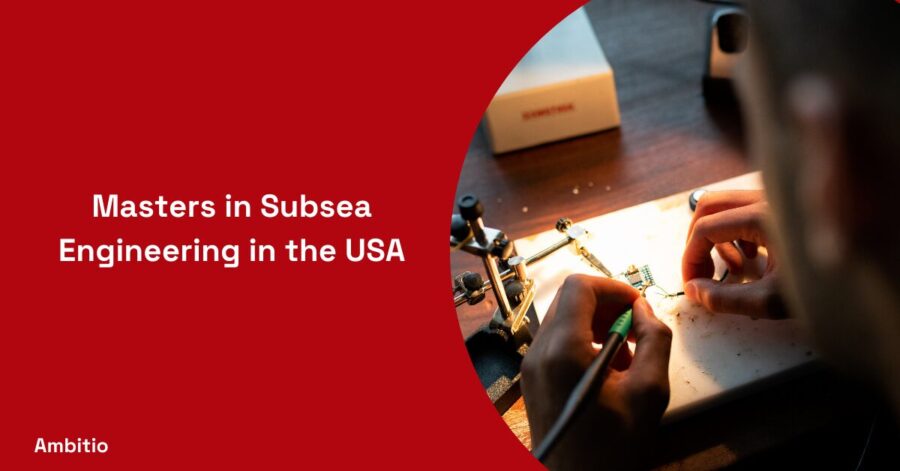11 December 2024
7 minutes read
Masters in Subsea Engineering in the USA

Key Takeaways
- Diverse Careers: Master’s in Subsea Engineering leads to various offshore industry roles.
- Comprehensive Education: Programs at universities like Houston and Texas A&M cover multiple engineering disciplines.
- Industry Ties: Strong connections offer practical insights and real-world challenges.
- Research Opportunities: Access to cutting-edge research and projects in advanced fields.
- Financial Support: Numerous scholarships and aids are available for students.
Subsea engineering is a dynamic and vital field in the offshore oil and gas industry. The role of a subsea engineer is crucial in designing, implementing, and maintaining subsea systems that are integral to offshore petroleum extraction.
Recognizing the importance of specialized education in this area, leading institutions like the University of Houston and Texas A&M University offer comprehensive master’s in subsea engineering programs.
This article delves into the various aspects of these programs, highlighting how they prepare graduates for a successful career in subsea engineering.
Understanding Subsea Engineering
Subsea engineering, an engineering field that combines mechanical, marine, and petroleum engineering principles, plays a pivotal role in the efficient and safe extraction of offshore oil and gas resources. As subsea engineers, graduates are tasked with the critical responsibility of ensuring the integrity and functionality of complex subsea systems.
These systems, comprising risers, umbilicals, and flowlines, operate under challenging marine conditions and are essential for the transportation and control of extracted resources from the seabed to topside facilities.
Top Universities Offering Masters in Subsea Engineering in the USA
| Serial Number | University | Program Highlights | Location | Program Duration | Mode of Study |
|---|---|---|---|---|---|
| 1 | University of Houston | Nation’s first graduate subsea engineering program, a strong focus on offshore wind energy, member of the Global Subsea University Alliance | Houston, Texas | 2 years | On-campus and Online |
| 2 | Texas A&M University | Strong industry collaboration, Offshore Technology Research Center, emphasis on practical knowledge from industry experiences | College Station, Texas | 2 years | On-campus and Online |
| 3 | Massachusetts Institute of Technology (MIT) | Pioneering research in marine engineering, extensive industry partnerships, cutting-edge facilities | Cambridge, Massachusetts | 2 years | On-campus |
| 4 | Stanford University | Interdisciplinary approach, research opportunities in renewable energy, proximity to Silicon Valley | Stanford, California | 2 years | On-campus |
| 5 | University of Aberdeen | Strong focus on subsea engineering, close ties with the oil and gas industry, state-of-the-art facilities | Aberdeen, Scotland | 1 year (MSc) | On-campus and Online |
| 6 | Norwegian University of Science and Technology (NTNU) | Leading subsea technology research, collaboration with industry leaders, picturesque campus | Trondheim, Norway | 2 years | On-campus |
The University of Houston offers the nation’s first graduate subsea engineering program, highlighting its pioneering role in this specialized field and its commitment to addressing the evolving needs of the offshore oil and gas industry.
Career Prospects in Subsea Engineering
| Serial Number | Job Role | Responsibilities | Industries | Average Salary Range | Education Requirements | Experience Requirements |
|---|---|---|---|---|---|---|
| 1 | Project Manager | Oversee subsea projects, from planning to execution | Oil and Gas, Renewable Energy | Varies by experience and location | Bachelor’s degree in Engineering or related field | 5+ years in project management, preferably in subsea projects |
| 2 | Design Engineer | Design and optimize subsea equipment | Oil and Gas, Marine Research, Environmental Monitoring | Varies by experience and location | Bachelor’s or Master’s degree in Mechanical Engineering or relevant discipline | 3+ years of experience in subsea equipment design and optimization |
| 3 | Operations Specialist | Manage and maintain subsea systems and operations | Oil and Gas, Offshore Wind | Varies by experience and location | Bachelor’s degree in Engineering or related field | 4+ years of experience in subsea operations and maintenance |
| 4 | Subsea Robotics Engineer | Develop and maintain robotic systems for subsea applications | Oil and Gas, Robotics, Underwater Exploration | Varies by experience and location | Bachelor’s or Master’s degree in Robotics, Mechanical Engineering, or related field | 3+ years of experience in subsea robotics and automation |
| 5 | Environmental Scientist | Study and monitor the environmental impact of subsea activities | Environmental Consulting, Marine Conservation | Varies by experience and location | Bachelor’s or Master’s degree in Environmental Science or related field | 2+ years of experience in environmental monitoring and impact assessment |
| 6 | Subsea Inspection Engineer | Conduct inspections and assessments of subsea structures | Oil and Gas, Inspection Services | Varies by experience and location | Bachelor’s or Master’s degree in Engineering or related field | 3+ years of experience in subsea inspections and structural assessments |
Subsea engineering graduates are equipped for various roles within the offshore oil and gas industry. These roles range from project management, where engineers oversee the planning and execution of subsea projects, to specialized positions like design engineers who create and optimize subsea equipment.
The diverse job roles in this field require a solid foundation in engineering principles, coupled with specific skills in subsea systems and offshore operations.
Advantages of Studying Subsea Engineering in the USA
| Serial Number | Advantage | Description |
|---|---|---|
| 1 | Cutting-Edge Research | Access to advanced research and technology in subsea engineering, innovative projects in deep-sea robotics, advanced materials, and offshore energy |
| 2 | Networking Opportunities | Connections with industry professionals, alumni networks, and academic experts for internships, job placements, and career advancement |
| 3 | Global Collaboration | Opportunities for international collaboration through partnerships with global institutions, fostering a diverse and global perspective |
| 4 | State-of-the-Art Facilities | Access to modern laboratories, testing facilities, and simulation tools for hands-on experience in subsea engineering applications |
| 5 | Industry Exposure | Exposure to real-world challenges through industry partnerships, site visits, and guest lectures from professionals in the subsea engineering field |
| 6 | Interdisciplinary Learning | Collaboration with experts from various disciplines, fostering a holistic approach to problem-solving in subsea engineering projects |
Admission Requirements and Application Process
Admission Requirements:
- Bachelor’s Degree:
- A bachelor’s degree in engineering or a closely related field from an accredited institution.
- A bachelor’s degree in engineering or a closely related field from an accredited institution.
- Academic Performance:
- A minimum GPA, is typically around 3.0 or higher, although this can vary by university.
- A minimum GPA, is typically around 3.0 or higher, although this can vary by university.
- GRE Scores:
- GRE scores may be required, depending on the university’s policy. Check specific program requirements for details.
- GRE scores may be required, depending on the university’s policy. Check specific program requirements for details.
- Work Experience:
- Relevant work experience in engineering or a related field can be beneficial, though not always mandatory.
- Relevant work experience in engineering or a related field can be beneficial, though not always mandatory.
- Letters of Recommendation:
- Typically two or three letters of recommendation, preferably from academic or professional references who can attest to the applicant’s qualifications and potential for success in a graduate program.
- Typically two or three letters of recommendation, preferably from academic or professional references who can attest to the applicant’s qualifications and potential for success in a graduate program.
- Statement of Purpose:
- A personal statement or essay outlining the applicant’s career objectives, motivation for pursuing a master’s in subsea engineering, and any relevant experiences or skills.
- A personal statement or essay outlining the applicant’s career objectives, motivation for pursuing a master’s in subsea engineering, and any relevant experiences or skills.
- English Language Proficiency:
Quick Tips!
- Research Financial Aid: Investigate scholarship and funding opportunities early to understand eligibility and application requirements, which can significantly offset the cost of education.
- Leverage Industry Connections: Utilize networking opportunities provided through the program to build relationships with industry professionals, which can lead to internships, mentorships, and job opportunities post-graduation.
- Engage in Hands-On Learning: Take advantage of the practical components of the program, such as labs, field trips, and industry projects, to gain real-world experience and enhance your understanding of subsea systems.
Application Process:
- Research and Select Programs:
- Identify universities offering the program and understand their specific admission criteria.
- Identify universities offering the program and understand their specific admission criteria.
- Prepare and Take the GRE (if required):
- Schedule and prepare for the GRE well in advance of application deadlines if the program requires it.
- Schedule and prepare for the GRE well in advance of application deadlines if the program requires it.
- Gather Required Documents:
- Organize transcripts, test scores, letters of recommendation, statement of purpose, and any other required documents.
- Organize transcripts, test scores, letters of recommendation, statement of purpose, and any other required documents.
- Submit the Application:
- Complete the online application form for each university, paying close attention to individual requirements and deadlines.
- Complete the online application form for each university, paying close attention to individual requirements and deadlines.
- Application Fee:
- Pay the non-refundable application fee, which varies by institution.
- Pay the non-refundable application fee, which varies by institution.
- Interviews (if required):
- Some programs may require an interview as part of the application process, either in person or remotely.
- Some programs may require an interview as part of the application process, either in person or remotely.
- Track and Follow-Up:
- After submitting applications, monitor their status and follow up with universities if necessary to ensure all materials have been received.
- After submitting applications, monitor their status and follow up with universities if necessary to ensure all materials have been received.
- Acceptance and Enrollment:
- Once accepted, follow the university’s instructions for enrollment, which may include submitting additional documentation and paying a deposit to secure your place.
- Once accepted, follow the university’s instructions for enrollment, which may include submitting additional documentation and paying a deposit to secure your place.
Financial Considerations for International Students
Tuition Fees and Living Expenses
International students should carefully consider the financial aspects of studying in the USA. Tuition fees for subsea engineering programs can vary significantly between institutions and are typically higher for international students.
Additionally, living expenses, including accommodation, transportation, and food, can vary depending on the location of the university.
| Serial Number | University | Tuition Fees (per year, approx.) | Living Expenses (per year, approx.) |
|---|---|---|---|
| 1 | University of Houston | $20,000 – $30,000 (for international students) | $12,000 – $18,000 |
| 2 | Texas A&M University | $25,000 – $35,000 (for international students) | $10,000 – $15,000 |
| 3 | Massachusetts Institute of Technology (MIT) | $53,790 (for international students) | $18,240 – $20,950 |
| 4 | Stanford University | $56,169 (for international students) | $19,872 |
| 5 | University of Aberdeen | £20,950 – £30,950 (for international students) | £12,180 – £16,250 (for international students) |
| 6 | Norwegian University of Science and Technology (NTNU) | NOK 74,000 (for international students) | NOK 128,000 (for international students) |
Subsea engineering is the cornerstone of successful and sustainable offshore resource extraction, driving innovation in one of the most challenging engineering environments on Earth.
– University of Houston
Scholarships and Financial Aid Options
Many universities offer scholarships and financial aid to support students, including those in subsea engineering programs. These scholarships can be merit-based, need-based, or specific to certain demographics or study areas.
Prospective students should research available options and understand the application processes for these financial resources.
| Serial Number | University | Scholarship/Funding Opportunities | Eligibility Criteria |
|---|---|---|---|
| 1 | University of Houston | Various merit-based and need-based scholarships, grants | Academic excellence, financial need, specific demographics or study areas |
| 2 | Texas A&M University | Merit-based scholarships, assistantships, and fellowships | Academic achievement, research potential, departmental needs |
| 3 | Massachusetts Institute of Technology (MIT) | MIT Presidential Fellowship, MIT Graduate Fellowships | Merit-based, outstanding academic achievements, research potential |
| 4 | Stanford University | Stanford Graduate Fellowships, Knight-Hennessy Scholars | Varies by program, academic excellence, leadership qualities |
| 5 | University of Aberdeen | Aberdeen Global Scholarship, Chevening Scholarships | Merit-based, academic achievement, potential to contribute to the University and society |
| 6 | Norwegian University of Science and Technology (NTNU) | Quota Scheme Scholarships, NTNU Tuition Waiver | Merit-based, academic qualifications, international students from specific countries |
Conclusion
A master’s degree in subsea engineering opens doors to a rewarding and challenging career in the offshore oil and gas industry. With comprehensive programs offered by top universities like the University of Houston and Texas A&M University, graduates are well-equipped with the necessary skills and knowledge to excel in this field.
By choosing to specialize in subsea engineering, students embark on a journey that not only enhances their professional prospects but also contributes to the advancement of offshore technology and resource extraction.
Personalized Solutions for Your Application: Get bespoke advice on your college application. Choose a date and time for a call with our mentor and move closer to your college goals.
FAQs
What is a Master’s in Subsea Engineering?
A Masters in Subsea Engineering is a graduate program focusing on the design, construction, and maintenance of equipment and infrastructure used in underwater oil and gas extraction.
Which universities offer a Masters in Subsea Engineering in the USA?
Notable universities offering this program include the University of Houston and Texas A&M University, both providing comprehensive curricula and research opportunities in the field.
What are the career prospects after completing a Master’s in Subsea Engineering?
Graduates can pursue careers as project managers, design engineers, or operations specialists in industries like oil and gas, renewable energy, and marine research.
Are scholarships available for Masters in Subsea Engineering programs?
Yes, many universities offer scholarships and financial aid based on merit, need, or specific demographics for students in subsea engineering programs.
Can I study Master’s in Subsea Engineering online?
Yes, some universities, such as the University of Houston and Texas A&M University, offer online as well as on-campus options for their subsea engineering programs.

You can study at top universities worldwide!
Get expert tips and tricks to get into top universities with a free expert session.
Book Your Free 30-Minute Session Now! Book a call now




























